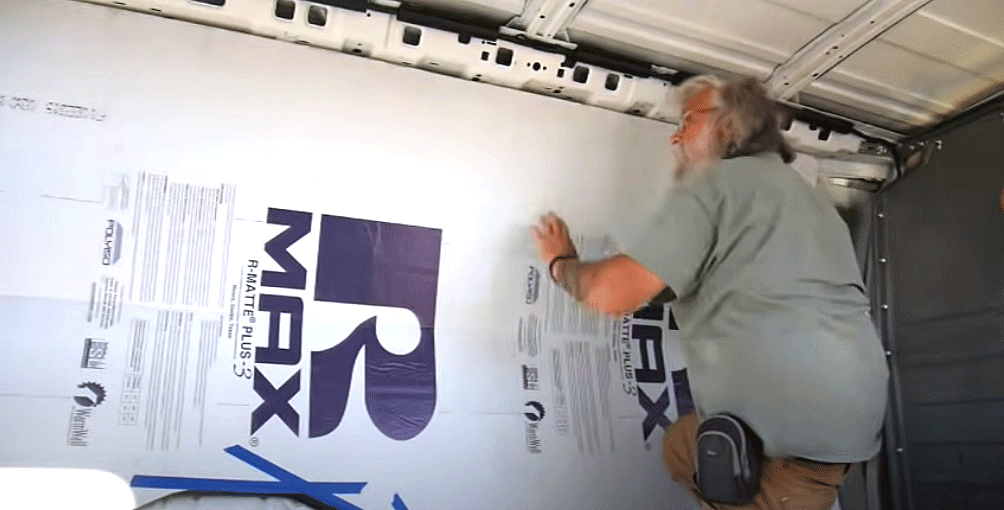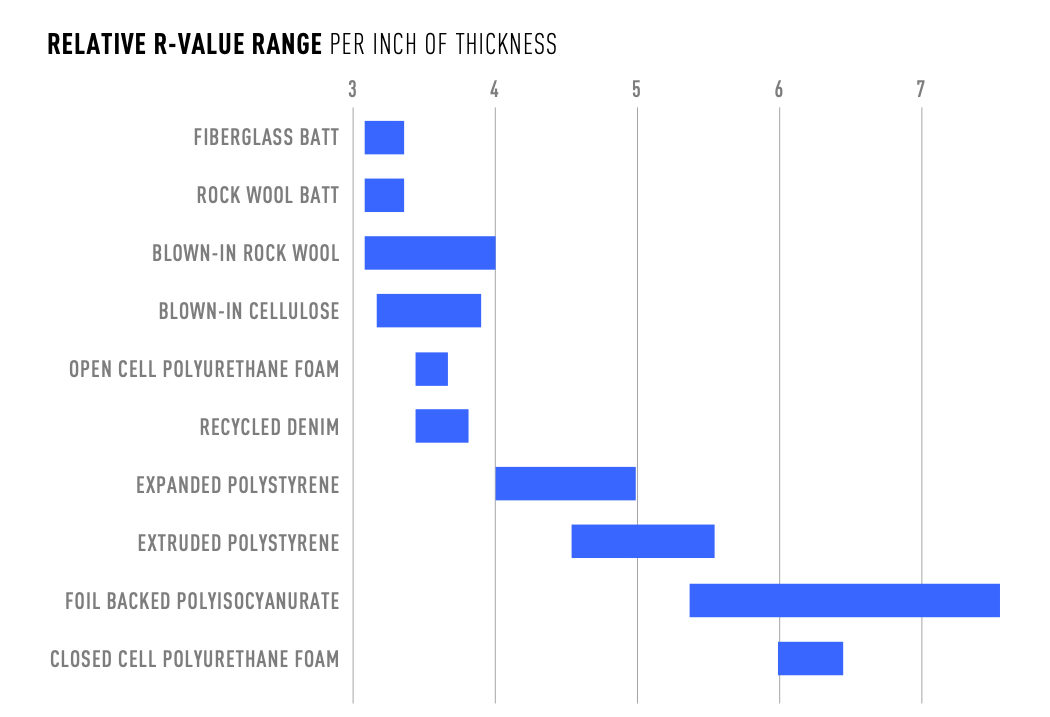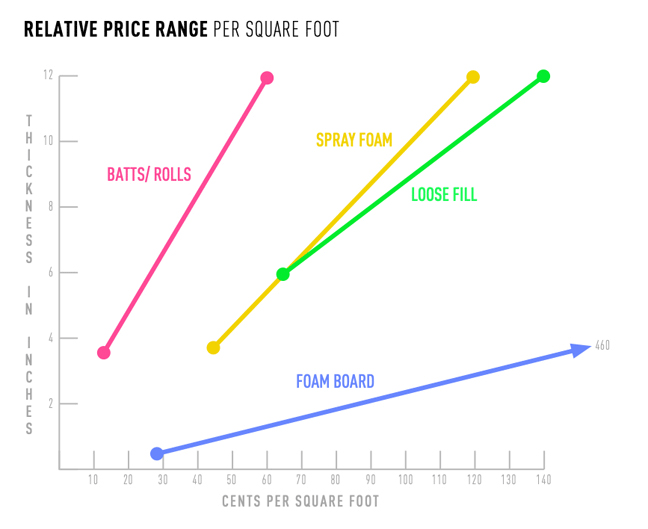
WELCOME BACK to the second installment of our insulation presentation. First some terms:
R-value: a relative rating of insulating effectiveness as determined under certain laboratory conditions which some people say don’t represent many real world conditions.
Thermal Drift: the loss of R-value over time due to the collapse or other degradation of the insulation.
Thermal bridging: loss of insulation effectiveness due to things like studs, joists, plumbing and electrical boxes that are more conductive than insulation or that cause gaps in insulation
Open cell: the tiny air pockets that do most of the work of insulating are open to intrusion from external air and water.
Closed cell: the air pockets are sealed off from external elements
Okay, let’s examine various common insulation materials.

FIBERGLASS
This is probably the most common type of insulation in home construction. It’s made from sand, soda ash, limestone and recycled glass that’s melted together and spun into fibers. The fibers are formed in to batts—with or without paper or foil facing—rolls, boards, or left loose for blow-in applications. Fiberglass works by trapping air between the fibers and is most effective when it’s nice and fluffy, not compacted. Stuffing more of it into a space will decrease its R-value. An alternative, then, are water heater blankets. They aren’t as thick and they’re easier to buy in small quantities.
Pros: Relatively inexpensive; readily available; can be cut with scissors; no off-gassing; no CFCs
Cons: Not waterproof, becomes compacted when wet, losing all insulating properties while promoting the growth of mild, mildew, fungi; can shift and sag, compromising its insulating properties; creates irritating fibers when working with it; less fire resistant than rock wool
ROCK WOOL
Rock wool—also called mineral wool or stone wool—is made from basalt, slag, coke and recycled rock wool waste spun into fibers and formed into batts of various thicknesses and densities. It serves as both thermal and acoustic insulation.
Pros: High R-value; more dimensionally stable than fiberglass; almost no thermal drift; water repellant; fire resistant; no off-gassing; no CFCs; can be cut with a bread knife
Cons: About twice the price of fiberglass; creates irritating fibers when working with it
EXPANDED POLYSTYRENE (EPS)
Polystyrene pellets are packed into a mold then puffed up (expanded) by heat and a blowing agent. This also sticks the expanded beads together. Pockets within and between the beads create still air that resists thermal transfer. In fact, EPS is 98% air. Some EPS sheets are bonded to a plastic or foil film for increased moisture resistance or to act as a radiant barrier.
Pros: Highest R-value per dollar; no thermal drift; mold and mildew resistant; no off-gassing; no CFCs or HCFCs; 100% recyclable
Cons: Can attract termites and ants; covered with a fire retardant that is dangerous to health, yet it is still flammable; moisture can be absorbed between the beads; unless you use an electric hot knife to cut it it scatters beads everywhere; can be too stiff to bend to follow curved walls and roofs; not biodegradable
EXTRUDED POLYSTYRENE (XPS)
XPS starts with the same polystyrene but it’s turned into a foam instead of beads. The foam is pumped through high pressure extruders forming sheets that expand during the cooling process. The different colors of XPS only designate the manufacturer, not any technical differences. XPS has a closed cell structure with no open gaps, as with EPS.
Pros: Slightly higher R-value than EPS; no thermal drift; closed cell structure; more mold and mildew resistant than EPS; no off-gassing; 100% recyclable; cuts cleanly
Cons: Costs slightly more than EPS; can attract termites and ants; uses HFCs as a blowing agent; covered with a fire retardant that is dangerous to health, yet it is still flammable; not biodegradable
POLYISOCYANURATE (polyiso or PIR)
Polyiso panels are formed by spraying a chemical foam onto an aluminized foil. Some versions have shiny foil on one side, others have foil on both sides, with one side being matte white rather than shiny. The foil not only increases air and moisture resistance, it also acts as a radiant barrier. It should be installed with the shiny side facing the heat source, inhibiting thermal radiation. The puzzle for us vehicle dwellers is whether it’s more desirable to keep heat in or out.
Pros: very high R-value for its thickness; both a radiant and conductive barrier; very low water absorption and vapor transmission; resilient to adhesives and finishes; its blowing agent doesn’t effect the ozone layer
Cons: more expensive than EPS or XPS; covered with a fire retardant that is dangerous to health; experiences thermal drift at low temperatures as gases trapped inside condense
SPRAY FOAM
A foam of isocyanate and polyol resin is pressurized and sprayed, creating polyurethane. The foam is sprayed directly on the surface or into the cavity you want to insulate. There are two types: open cell and closed cell. Open cell expands more, weighs less and absorbs sound well. Closed cell expands less, is denser and has a higher R-value. Open cell foam should be avoided in vehicles since it can trap moisture that could lead to rust and corrosion. Also, the chemicals in some spray foams might react negatively with vehicle paint. If you want to go this way, make sure the foam is auto paint compatible.
Pros: Rapid installation; no air or water gaps at the edges; no thermal drift
Cons: A more technical, equipment-dependent installation; not DIY-friendly; higher costs
CELLULOSE
Cellulose insulation is made from recycled paper products and wood manufacturing waste and has an R-value similar to fiberglass. Shredded paper is chemically treated to prevent decay and inhibit mold and mildew. Cellulose is sometimes made into batts but is most commonly found as blocks of loose fill. It is sprayed either dry or wet (then left to thoroughly dry before enclosing). It can be crumbled and scattered by hand rather than pumped through a sprayer, but that results in a much lower R-rating. Dry sprayed or hand scattered cellulose will settle and shift with the movement of a vehicle, causing thermal drift.
Pros: eco-friendly alternative to fiberglass and petrochemical-based insulation materials; no off-gassing; fits easily into irregular cavities
Cons: intended for spray application, less effective when applied by hand; dusty to work with; somewhat moisture absorbent because of its ability to be sprayed wet; not a good choice for vehicles
RECYCLED DENIM
As with cellulose, old jeans and other cotton fabrics are shredded and chemically treated for flame, moisture and pest resistance. It’s available as rolls, batts and loose fill. It’s R-value is slightly higher than fiberglass but costs about twice as much.
Pros: high recycled eco-friendly material content; no off-gassing; very flexible and easy to fit to curved surfaces; no dust or irritation when working with it; cuts easily with scissors; good acoustic insulation properties
Cons: very moisture absorbent despite being treated; few manufacturers

SOME THINGS TO CONSIDER
Batts are intended to be used between wall studs and floor/ceiling joists. But most vehicles don’t have studs or joists—at least not ones matching building construction specs. Rigid foam boards can flex a little to accommodate curved surfaces, like van walls and roofs, but the thicker the boards the less they bend. You might need to use multiple layers, like two 1” boards instead of one 2” board. Bending isn’t an issue with the flat walls of box vans, step vans and cargo trailers. Foam boards are also trickier to cut so they fit odd shapes, or to get into cavities with small openings.
SO, WHICH IS BEST?
There’s no single right answer. Your choice depends on which factors are more important to you. Price? R-value? Eco-friendliness? Ease of installation? Where in the vehicle it’s going to be used? The climate where you’ll spend most of your time? The best answer for your situation will probably be a compromise. But some insulation, any insulation, is usually better than none.

Is the relative R value chart missing some numbers? I’m not sure how to read it as shown.
Polystyrene is recyclable? Is that a general statement on the material or do some municipalities / waste collectors actually accept it. I’ve used the pink foam in model building, and I don’t believe I’ve ever seen it marked as recyclable.
The numbers 3 through 7 are the R values. The ranges (like 4 to 5 for EPS) are based on the thickness range of the material. Thicker — higher R value for that product.
According to the sources for the article, polystyrene is recyclable, but it’s usually only accepted by specialty recyclers.